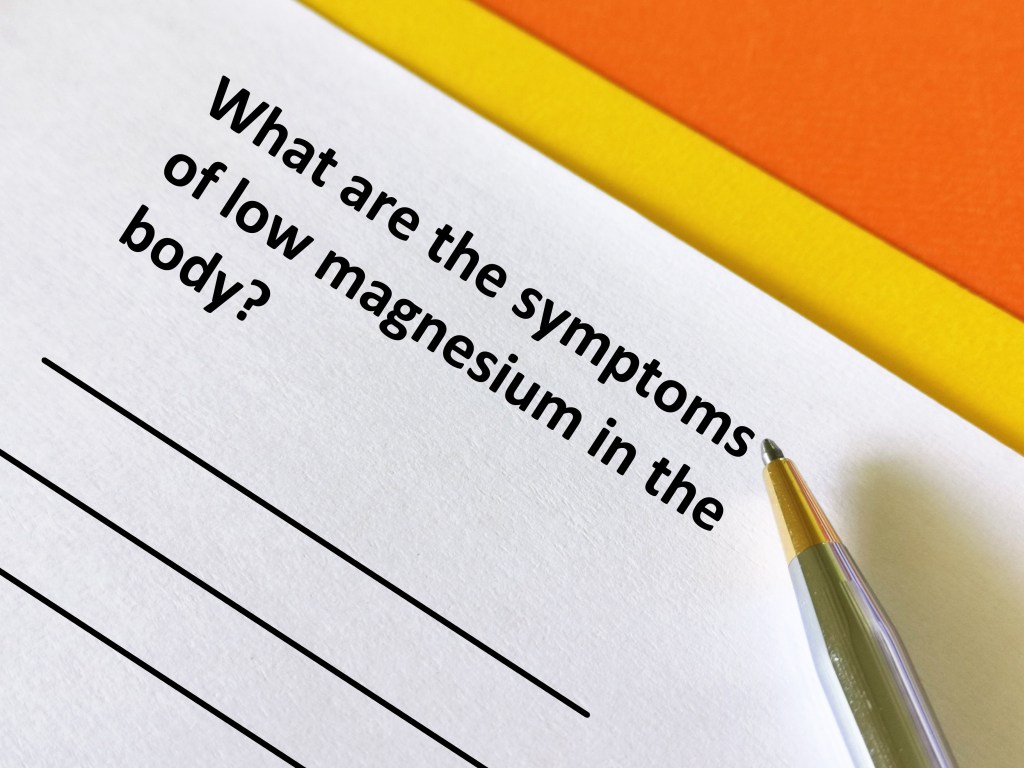At a glance
The benefits of magnesium extend across many essential bodily functions, yet deficiency is common due to inadequate intake or reduced absorption. Because magnesium supports muscles, nerves, bones, and overall metabolic health, maintaining sufficient levels is crucial for maintaining steady energy and promoting healthy daily function.
Magnesium is an essential mineral involved in over 300 enzymatic reactions in the body, playing a key role in crucial physiological processes, including energy production and heart rhythm regulation.
Found in foods such as leafy greens and nuts, magnesium supports critical functions, including muscle contraction, bone health, and nerve signal transmissions.
Discover seven benefits of magnesium and learn how this powerhouse nutrient can enhance physical performance and reduce stress.
What is magnesium?
Magnesium is an essential mineral that plays a critical role in muscle function, nerve transmission, and cellular energy production.
It also helps maintain a steady heartbeat, supports healthy bone structure, and assists in regulating balanced blood glucose levels.
While magnesium is found in various foods such as spinach, almonds, and avocados, many individuals don’t consume enough due to modern dietary habits and certain lifestyle factors, which may lead to magnesium deficiency.
Though symptoms and severity can vary, magnesium deficiency may affect muscle performance, mood regulation, and energy levels.
According to the National Institutes of Health (NIH), the recommended dietary allowance (RDA) for magnesium varies by age and gender.1
Here’s how much magnesium you should obtain daily based on gender and age:
- Males, 19-30 years: 400 mg
- Males, 31 years and older: 420 mg
- Females, 19-30 years: 310 mg
- Females, 31 years and older: 320 mg
Because magnesium supports cardiovascular health and has been linked to better blood pressure regulation, it’s important to maintain optimal levels through nutritious whole foods.
Watch the video below to learn more about the impressive health benefits of magnesium.
7 benefits of magnesium
Although magnesium supports many of the body’s core functions, it’s often overlooked in daily nutrition. From muscle movement to nervous system balance, magnesium is essential for helping your body operate efficiently.
Here are seven health benefits of maintaining optimal magnesium intake.
1. Supports energy production
Magnesium is crucial for helping the body generate energy as it’s needed to activate enzymes that produce adenosine triphosphate (ATP), which is the primary fuel source of the body’s cells and tissues.
Without sufficient magnesium, the cellular ability to convert macronutrients into ATP is impaired, leading to fatigue, reduced endurance, and an overall decline in physical and mental performance.
2. Promotes bone health
Magnesium may help maintain bone structure by regulating calcium transport and supporting vitamin D metabolism.
It also contributes to bone mineral density and is stored primarily in the bones, where it supports long-term skeletal integrity and resilience.
This is supported by a study published in Biometals, which found that those who consistently consumed less magnesium than recommended showed reduced skeletal strength and a greater risk of fractures.2
3. Assists in muscle function
“Magnesium is an essential mineral involved in approximately 800 biochemical reactions in the body, many of which are critical for muscle health,” explains Dr. Berg.
Magnesium works in combination with calcium in muscle function. While calcium triggers muscle contraction, magnesium is needed to relax the muscles afterward, helping to prevent cramping, tightness, and spasms.
Maintaining optimal magnesium levels is vital for preserving skeletal muscle integrity, especially as the body ages.

4. Help maintain balanced nervous system regulation
Magnesium supports a balanced nervous system by regulating neurotransmitters that facilitate nerve signal transmission throughout the brain and body.
Moreover, research published in Frontiers in Endocrinology found that “magnesium helps prevent events that could otherwise lead to intensified inflammation and neuronal injury.” 3
This highlights magnesium’s integral part in protecting nerve cells from overstimulation and stress-related damage, helping to maintain long-term neural stability.
5. Supports healthy blood sugar levels
Evidence published in Diabetes Care showed that magnesium may help lower fasting blood sugar levels, which is crucial for those with diabetes and insulin sensitivity.4
It also revealed positive effects on markers of insulin sensitivity, linked to magnesium’s role in helping insulin bind to its receptors and supporting the movement of glucose into cells.
Additionally, maintaining adequate magnesium levels has been associated with better regulation of carbohydrate metabolism, which is essential for balanced blood sugar control.

6. Promotes cardiovascular health
A study published in Advances in Chronic Kidney Disease has found that low magnesium levels are associated with a greater risk of cardiovascular conditions such as atherosclerosis and arrhythmias.5
Adequate magnesium intake may support optimal heart function by helping regulate nerve signals, heartbeat rhythm, and blood vessel tone.
7. May offer antioxidant effects benefits
Magnesium deficiency has been linked to increased oxidative stress, which occurs when unstable molecules called free radicals damage cells and disrupt normal biological functions.
Lack of magnesium is also associated with elevated oxidative markers that affect lipids, proteins, and DNA. This can increase the risk of chronic diseases such as cardiovascular disease, neurodegeneration, and certain types of cancer.

What causes low magnesium?
Low magnesium can result from various factors that disrupt the body’s ability to absorb or retain this essential mineral.
Inadequate dietary intake is a common cause, especially when meals lack magnesium-rich foods such as leafy green vegetables, nuts, and seeds.
Additionally, certain lifestyle factors, such as excessive alcohol consumption or high levels of physical stress, can reduce magnesium levels by increasing urinary mineral loss.
Individuals with low stomach acid and poor digestive functions, as well as those with intestinal tract disorders, such as Crohn’s disease or celiac disease, may also struggle to absorb magnesium efficiently, leaving them at risk of deficiency.
Certain medications, such as diuretics, proton pump inhibitors (PPIs), and certain antibiotic drugs, may also interfere with magnesium absorption or promote excretion, further contributing to deficiency.

Signs of magnesium deficiency
While mild magnesium deficiency may go unnoticed, more pronounced or prolonged low levels can lead to noticeable physical and neurological signs.
Here are common signs of magnesium deficiency:
- Muscle cramps or spasms
- High blood pressure
- Abdominal and digestive discomfort
- Migraine headaches
- Irregular heartbeat
- Changes in blood sugar regulation
- Numbness or tingling
If you have developed signs of low magnesium or are concerned about your nutritional status, it’s recommended to consult a healthcare provider for an evaluation of your symptoms and personalized advice.
A blood test is typically used to evaluate magnesium status and determine whether additional intake is needed.

Best natural sources of magnesium
Getting enough magnesium through nutritional whole foods is one of the most effective ways to maintain optimal levels and support your body’s daily functions.
Here are some of the best natural magnesium sources.
Green leafy vegetables
Spinach, Swiss chard, and kale are excellent sources of magnesium thanks to their high chlorophyll content. Chlorophyll binds magnesium at the center of its molecular structure, making these leafy greens rich natural sources of the mineral.
Nuts and seeds
Unlike many packaged snacks, almonds, pumpkin seeds, and sunflower seeds are magnesium-rich foods that also offer protein and beneficial fats.
Seeds and nuts are ideal for on-the-go nutrition without added sugars or preservatives.
Oily fish
Fatty fish species such as salmon, mackerel, and halibut offer magnesium while providing health-promoting omega-3 fatty acids.
In combination, these essential nutrients support heart and muscle function, promote cellular health, and enhance overall health and well-being.
Avocados
Creamy and nutrient-rich, avocados offer magnesium, potassium, and healthy fats, making them a nutritional powerhouse.
Whether spread on toast or sliced into a salad, they’re an easy way to boost your mineral intake.
Dark chocolate
In moderation, dark chocolate can be a satisfying way to increase magnesium intake, as it contains a significant amount of this mineral along with antioxidants and other beneficial nutrients.
Opt for unsweetened varieties with at least 70 percent cocoa content to ensure the best quality and a higher mineral concentration.
Key takeaways
- The benefits of magnesium include supporting energy production, muscle relaxation, bone integrity, nerve regulation, healthy blood sugar levels, and cardiovascular function.
- Low magnesium levels can result from inadequate dietary intake, poor absorption, chronic stress, excessive alcohol consumption, digestive issues, or the use of medications that increase mineral loss.
- Signs of magnesium deficiency may include muscle cramps, digestive discomfort, migraines, changes in heartbeat or blood sugar regulation, or tingling sensations.
- Leafy greens, nuts, seeds, oily fish, avocados, and dark chocolate are among the best natural food sources to help maintain healthy magnesium levels.
- Individuals experiencing symptoms of low magnesium levels should consult a healthcare provider for evaluation.
FAQ
What are the benefits of magnesium?
Magnesium plays a vital role in energy production, helps maintain bone strength, supports proper muscle function, and contributes to a balanced nervous system. Additionally, magnesium promotes healthy blood sugar levels and supports cardiovascular health by assisting in heart rhythm regulation and blood vessel tone.
What are the top functions of magnesium?
Magnesium is involved in over 300 enzymatic reactions in the body, making it vital for everyday physiological processes. These include assisting in energy metabolism, supporting bone mineral structure, regulating nerve signaling, and helping muscles contract and relax properly. It also helps regulate blood glucose and plays a key role in maintaining a steady heartbeat and healthy nervous system communication.
What are the causes of low magnesium?
Low magnesium levels can result from inadequate dietary intake, especially in diets lacking magnesium-rich foods. Lifestyle factors such as chronic stress or high alcohol consumption can also increase magnesium loss through urine. Additionally, certain medications may reduce magnesium absorption or increase its excretion, making it harder for the body to maintain adequate levels.
What are the best sources of magnesium?
Some of the best natural sources of magnesium include spinach, kale, Swiss chard, and other green leafy vegetables. Nuts and seeds such as almonds and sunflower seeds are also rich in magnesium. Other great options include fatty fish, such as salmon and mackerel, as well as avocados and dark chocolate.
Sources
- https://ods.od.nih.gov/factsheets/Magnesium-HealthProfessional/ ?
- https://pmc.ncbi.nlm.nih.gov/articles/PMC8313472/ ?
- https://www.frontiersin.org/journals/endocrinology/articles/10.3389/fendo.2024.1406455/full ?
- https://diabetesjournals.org/care/article/37/2/419/29258/Higher-Magnesium-Intake-Reduces-Risk-of-Impaired ?
- https://pubmed.ncbi.nlm.nih.gov/29793664/ ?


















